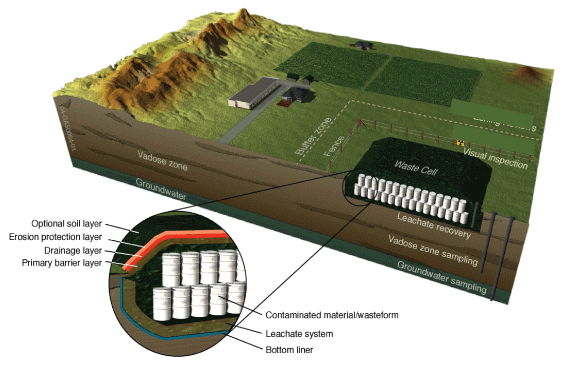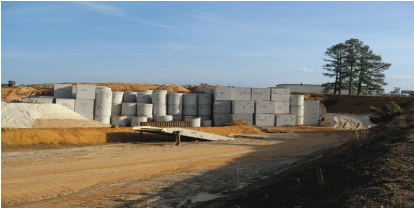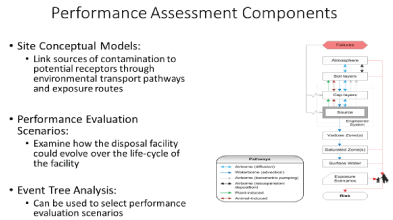A Systems Approach to Near Surface Disposal Facility Design
Abstract
A fundamental near-surface disposal challenge is the development and use of a risk-informed and performance-based decision tool that incorporates the impacts of waste, waste form and waste container-specific, facility design-specific and facility location-specific factors into the overall assessment of anticipated facility performance. This decision-making tool must have the ability to assess the influence of each disposal facility component on overall performance for specific wastes and disposal site environments.
In this analysis, we assemble a set of tools that can be used to provide this needed overall assessment of facility performance. These tools include conceptual site models, performance evaluation scenarios and event trees.
Introduction
Millions of tons of hazardous chemical and low-level radioactive waste have been disposed in near-surface disposal facilities (landfills). The US Environmental Protection Agency (EPA) takes a prescriptive design approach to the permitting of hazardous chemical waste landfills under the Resource Conservation and Recovery Act, such that, if the facility incorporates a specific design, a permit is awarded. Conversely, the approach used by the Department of Energy (DOE), for its on-site facilities, and the Nuclear Regulatory Commission (NRC), for licensed commercial nuclear waste facilities, is performance-based in accordance with specified performance objectives (Figure 1 and Figure 2).
Figure 1 provides a conceptual depiction of a modern near surface disposal facility, that meets EPA prescriptive design requirements. The cartoon shows the waste packages (drums), the waste disposal cell, with its various components designed to prevent waste from contacting the waste packages and leachate from leaving the disposal cell, the underlying subsurface hydrogeology and the overall disposal site environment.
Figure 2 shows a specific near-surface disposal facility for low-level Class A radioactive waste in Barnwell, South Carolina. This facility is licensed by the NRC and, unlike an EPA permitted facility, is not required to incorporate a bottom liner and associated leachate collection system. Various waste packages are present in a shallow trench excavated into an underlying low permeability clay.
The Elements of a Comprehensive Systems Evaluation Approach
We seek to develop a risk-informed and performance-based assessment and decision-making approach that can be used to evaluate potential and existing near-surface disposal facilities for low-level radioactive waste and hazardous chemical waste, taking into account important waste-specific and site-specific factors.
As an example, all DOE low-level radioactive waste near-surface disposal facilities must meet a set of performance objectives for a period of 1,000 years. The performance objectives are defined in DOE Radioactive Waste Management Order 435.1 and discussed in the DOE Radioactive Waste Management Manual 435.1-1. A performance assessment is the vehicle used to demonstrate attainment of the performance objectives.
The components of a comprehensive performance assessment include site conceptual models, that link sources and receptors through environmental transport pathways and exposure routes, performance evaluation scenarios and event tree analyses (Figure 3).
Our recommended systems approach incorporates the following elements into the performance assessment:
1. Near-surface facility design considerations e.g., the kinds of engineered barriers used and the leachate collection and management system if the facility is required to satisfy EPA requirements.
2. Waste-specific considerations specifically waste form and waste package features.
3. Environmental site-specific considerations specifically climate, geology and ecology.
Summary and Conclusions
The safe and environmentally-protective management of hazardous chemical and low-level radioactive waste in near surface disposal facilities requires a sound and comprehensive assessment of facility design elements. waste composition and waste container features and environmental site-specific conditions. A performance-based approach, to achieve stated performance objectives, has an additional advantage, in that potential changes in site conditions can be incorporated into the analysis as well, providing the opportunity for some resiliency.
Acknowledgements
The authors acknowledge helpful discussions with the members of Dr. Rustick's Ph.D thesis committee viz., Drs Craig Benson, David Kosson, Michael Ryan and Steven Krahn.
Corresponding Author
James H Clarke, Department of Civil and Environmental Engineering, Vanderbilt University, Nashville, Tennessee, USA.
Copyright
© 2018 Rustick JH, et al. This is an open-access article distributed under the terms of the Creative Commons Attribution License, which permits unrestricted use, distribution, and reproduction in any medium, provided the original author and source are credited.







